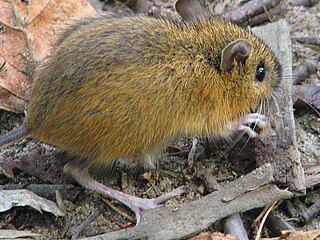
The woodland jumping mouse is a species of jumping mouse found in North America. Its Latin name means glen or wooded dell + big or strong feet + a distinguishing mark. This mammal can jump up to 3 m (9.8 ft) using its extremely strong feet and long tail.
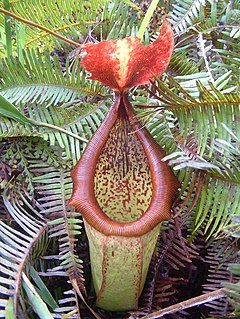
Nepenthes insignis is a tropical pitcher plant endemic to New Guinea and surrounding islands. The specific epithet insignis is Latin for "distinguished" or "remarkable".

The black house spider or common black spider is a common species of cribellate Australian spider, introduced to New Zealand and Japan. A closely related species, Badumna longinqua, the grey house spider, has a similar distribution, but has also been introduced to the Americas.

Brighamia insignis, commonly known as ʻŌlulu or Alula in Hawaiian, or colloquially as the vulcan palm or cabbage on a stick, is a critically endangered species of Hawaiian lobelioid in the bellflower family, Campanulaceae. It is native to the islands of Kauaʻi and Niʻihau. This short-lived perennial species is a member of a unique endemic Hawaiian genus with only one other species.
The Mindanao montane forest mouse is a species of rodent in the family Muridae. It is found only in the Philippines.
The montane African climbing mouse or remarkable climbing mouse is a species of rodent in the family Nesomyidae. It is found in Democratic Republic of the Congo, Kenya, Rwanda, Tanzania, and Uganda.
Oxynoemacheilus insignis is a species of stone loach It is restricted to the Damascus basin in Syria and to the Jordan-Dead Sea basin in Syria, Israel and Jordan. Its natural habitat is rivers. It is threatened by the drying up of the rivers and streams in which it is found, caused by overuse, damming and less rainfall, as well as by pollution. In Syria it has been extirpated from the Barada and can now only be found in the upper reaches of the Awaj to the west of Damascus. It is a highly variable species and different populations can differ from their neighbouring populations that in the past they have been described as species or subspecies and this has led to a large number of synonyms for Oxynoemacheilus insignis.

The brown-capped weaver is a species of bird in the Ploceidae family. It is found in Angola, Burundi, Cameroon, Republic of the Congo, Democratic Republic of the Congo, Equatorial Guinea, Kenya, Nigeria, Rwanda, South Sudan, Tanzania, and Uganda.
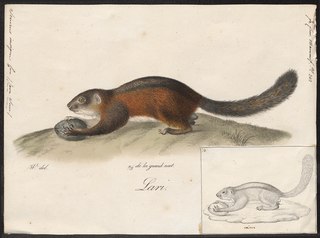
The three-striped ground squirrel is a species of rodent in the family Sciuridae. It is found in Indonesia, Malaysia, and Thailand.

The Cameroon scaly-tail, also referred to as the Cameroon anomalure, flightless anomalure, or flightless scaly-tail, is a rodent species endemic to West Central Africa. The scientific literature has never reported observations of live individuals. The taxonomic classification of the species has been subject to recent revision.
The one-and-a-half-stripe hap is a species of cichlid endemic to Lake Malawi where it prefers rocky areas. It is an egg-eater, seeking out and consuming the eggs of other fishes. This species can reach a length of 20.3 centimetres (8.0 in) TL. It can also be found in the aquarium trade.
P. insignis may refer to:
T. insignis may refer to:

Sphingnotus is a genus of beetle belonging to the family Cerambycidae.

Sphingnotus mirabilis is a species of beetle belonging to the family Cerambycidae.
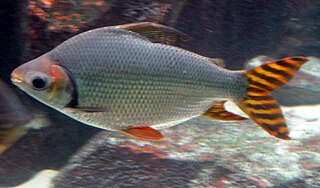
The kissing prochilodus or flag-tailed prochilodus is a species of South American freshwater fish in the family Prochilodontidae. It is native to central and western parts of the Amazon basin. It is migratory, moving in large groups into whitewater rivers to spawn, afterwards returning to blackwater and clearwater rivers, as well as flooded forests. It is important in fisheries and sometimes seen in the aquarium trade, but require a relatively large tank. It can reach a maximum length of 27.5 cm (10.8 in) and weight of 560 g (1.23 lb). It resembles the other members of the genus Semaprochilodus, where most species are silvery with orange-red fins and a striped tail. Adult S. insignis lack the dark flank spots that can be seen in adult S. taeniurus, but both species have these spots as juveniles.
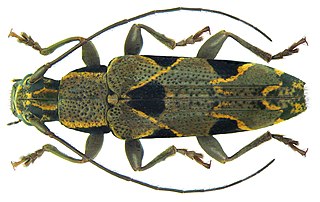
Tmesisternini is a tribe of beetles in the subfamily Lamiinae containing the following genera:

Sphingnotus dunningi is a species of beetle in the family Cerambycidae. It was described by Francis Polkinghorne Pascoe in 1867. It is known from Moluccas.
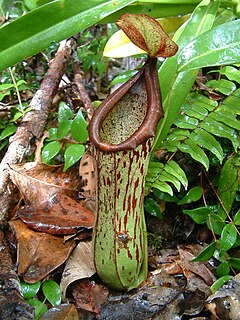
Nepenthes biak is a tropical pitcher plant endemic to the Indonesian island of Biak, after which it is named. Biak is a member of the Schouten Islands, located in Cenderawasih Bay, and is administered as part of Biak Numfor Regency, Papua Province. Nepenthes biak grows near sea level, usually on limestone coastal cliffs though occasionally as an epiphyte on mangrove trees.
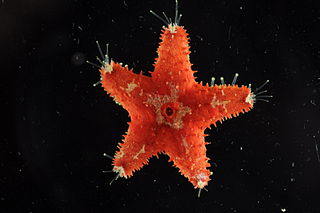
Euretaster insignis, commonly known as the striking sea star, is a species of starfish in the family Pterasteridae found in the central west Pacific Ocean. It is one of only three species in the order Velatida to be found in shallow water in the tropics. The young are brooded in a cavity underneath a "supradorsal" membrane.














